Giulia Ghiadristri
Numerical study of bentonite buffers homogenisation upon re-saturation
Started: Oct 2015
Supervisor: Zdravkovic, L.; Potts, D.M.; Tsiampousi, A.
Background

Studying bentonite re-saturation is a challenging task, as it involves swelling upon wetting from groundwater in the host formation and shrinkage induced by heat coming from the energy generated by the nuclear waste in the container. Nevertheless, a good understanding of the phenomenology involved is important to build confidence in modelling the long-term behaviour of the Engineered Barriers Systems (EBS) for nuclear waste disposal.
One of the disposal concepts being considered in the UK is to dispose of High Level Waste (HLW) and Spent Fuel in containers surrounded by a buffer material consisting of bentonite. In fact, this clay’s capacity to swell provides a low hydraulic conductivity barrier and protection of the container. Hence, it is of paramount importance to understand and be able to reproduce numerically the hydro-mechanical (HM) interaction as a key to the swelling of the buffer.
The material object of the present work is MX-80 bentonite, which is among the most suitable candidate to be employed as buffer in nuclear waste disposal.
For the investigation of the behaviour of unsaturated soils, a commonly adopted HM constitutive model is the Barcelona Basic Model (BBM) (Alonso et al., 1990). A modified BBM version (Georgiadis et al., 2003, 2005, Tsiampousi et al., 2011, Tsiampousi et al., 2013) is currently implemented in the Imperial College Finite Elements Program (ICFEP, Potts & Zdravkovic, 1999), which is the main research tool of the current research project.
Research aims
BBM-type formulations suffer from limitations in modelling the behaviour of very expansive soils (such as bentonite). Consequently, the Barcelona Expansive Model (BExM) was conceptually introduced (Gens & Alonso, 1992) and then fully developed (Alonso et al., 1999) to enable the modelling of such soils. BExM improves on its predecessor by taking into account a double porosity microstructure, typical of expansive soils.
Therefore, this research project consists of two parts.
- Formulation, implementation, validation of a HM constitutive model capable of appropriately reproducing bentonite re-saturation and swelling. The shortcoming of the BBM-type framework are analysed and used as starting point for the development of a BExM-type constitutive model. This new model is then tested, validated and calibrated against simple laboratory tests.
- 2. Analysis of increasingly complex simulations: from the simple geometrical tests to the self-healing of a larger cavity in a bentonite block and a full-scale repository test. The new model is exploited to gain a better understanding of bentonite re-saturation
Finally, practical recommendations for waste disposal techniques may be made, according to results.
References
Alonso, E. E., Gens, A., Josa, A. (1990) A constitutive model for partially saturated soils. Geotechnique 40 (3), 405-430.
Alonso, E. E., Vaunat, J., Gens, A. (1999) Modelling the mechanical behaviour of expansive clays. Engineering Geology 54 (1-2), 173-183.
Gens, A., Alonso, E.E. (1992) A framework for the numerical behaviour of unsaturated Boom clay: an experimental of unsaturated expansive clays. Canadian Geotechnical Journal 29, 1013-1032.
Georgiadis, K., Potts, D. M., Zdravkovic, L. (2005) Three-dimensional constitutive model for partially and fully saturated soils. International Journal of Geomechanics 5(3), 244-255.
Georgiadis, K., Potts, D. M., Zdravkovic, L. (2003) The influence of partial soil saturation on pile behaviour. Geotechnique 53, No. 1, 11–25.
D.M. Potts and L. Zdravkovic, (1999) “Finite element analysis in geotechnical engineering: theory”, London: Thomas Telford.
Tsiampousi, A., Zdravkovic, L., Potts, D. (2013) A new Hvorslev surface for critical state type unsaturated and saturated constitutive models Computers and Geotechnics 48, 156-166.
Tsiampousi, A., Zdravkovic, L., Potts, D. (2013) A three-dimensional hysteretic soil-water retention curve Geotechnique 63, No. 2, 155–164.
Giulia Ghiadistri
 PhD Candidate - Geotechnics
PhD Candidate - Geotechnics
Department of Civil & Environmental Engineering
Imperial College London SW7 2AZ
g.ghiadistri15@imperial.ac.uk


